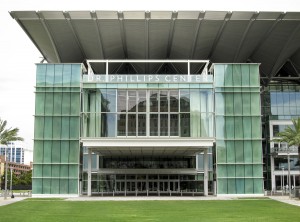Foresight is 2020
 The upcoming year will bring more growing pains for metro Orlando as the area continues to add residents at a dizzying pace.
The upcoming year will bring more growing pains for metro Orlando as the area continues to add residents at a dizzying pace.
Now that another year has come to a close, it’s time to look forward at what’s on the horizon. So, to learn more about what the future will bring, Orlando Family Magazine spoke with local leaders about what 2020 will hold for Greater Orlando. The biggest takeaway: Central Florida’s rapid population growth—an addition of 1,500 people per week according to the Orlando Economic Partnership—will continue to impact the region, providing new opportunities but also new challenges.
HEALTH CARE
The Affordable Care Act, passed in 2010, made it a requirement for nonprofit health care providers to assess the needs of their communities once every three years. Recently, Central Florida’s nonprofit hospitals and health organizations did just that and released a 2019 Community Health Needs Assessment (CHNA) looking at the counties of Lake, Seminole, Osceola and Orange.
Ellis Perez, epidemiology program director for the Florida Department of Health in Orange County, says the report is intended to provide necessary information to health care organizations, so they can create strategic plans to better address the population’s needs. The Florida Department of Health in Orange County contributed to the report and Perez coordinated the effort as population health & quality improvement data manager, her position at the time.
Perez says one of the biggest takeaways from the report is that Central Florida’s rapidly increasing population is putting pressure on the area’s health organizations.
Dr. Debra Andree, chief medical officer for Community Health Centers, agrees that the region’s growing population is something health care providers need to keep up with.
“The rate of growth that Central Florida is experiencing presents a challenge in and of itself,” Dr. Andree says. “And to try and keep up with the demand will be a challenge, one that not just Community Health Centers, but every organization in the needs assessment is looking at and planning for.”
Community Health Centers is currently expanding its footprint in Central Florida in an effort to serve more of the area’s population.
One finding from the CHNA report was that the two leading causes of death in Lake, Orange, Osceola and Seminole counties are cardiovascular disease and cancer. Dr. Andree says more can be done to help starting in 2020 to address these diseases.
“Early intervention and screenings help prevent the rate of disease advancement and that’s crucial,” she says.
Free or low-cost screenings can help improve outcomes for people with cancer or cardiovascular disease. For example, Dr. Andree says, if more people had access to free or low-cost mammograms, breast cancer could be identified in its early stages, allowing doctors to treat the cancer more successfully.
The CHNA report also identified infant mortality as a concern for a couple of counties in Central Florida. Perez says there are many ways to improve outcomes for babies and those suffering from chronic disease.
“Infant mortality and chronic disease conditions are concerning health indicators that could be addressed through increased community partnership, community education and promotion of health services, and increased funding opportunities for community interventions,” she said in an email.
Other concerns of the population that were gleamed by the report include access to mental health services and health care that is affordable.
HOUSING
Throughout 2019, Central Florida’s housing market has struggled with a lack of inventory. Reese Stewart, president of the Orlando Regional Realtor Association (ORRA), predicts this will stay about the same in 2020.
“We expect to see the continuation of market conditions, especially within the lower price categories where lack of inventory is significant,” he says.
According to ORRA’s November report, there is less than a three-month supply of homes on the market in Orlando, indicating that there is demand but not enough homes on the market to satisfy buyers—making it firmly a seller’s market.
A six-month supply of homes is considered a market that is balanced between buyers and sellers.
However, while this is the case with most homes in the Orlando area, when it comes to luxury homes, it’s a different story.
“Data shows that the price point at $800,000 and above is firmly in a buyer’s market territory,” Stewart says.
As of November 2019, the median price for a house in Orlando was 3% higher than it was at the same time last year. The area’s median price has steadily risen this year, another trend that Stewart predicts will continue.
“We expect Orlando’s overall median price to continue rising at this healthy, measured pace in 2020,” he says.
While a lack of inventory and a rising median price have presented a challenge for buyers, Stewart says the favorable mortgage interest rate has helped and will continue to in 2020.
“What’s going to happen is low interest rates will still stimulate the demand and the strong economy in Orlando will also simulate some demand,” he says. “And the continued interest from international home buyers and investors, that’s going to bolster sales, especially in the upper price ranges.”
Orlando’s expanding population is affecting the area’s housing market, too.
“It’s reported that 1,500 new residents are moving into Orlando every week, so we expect the overall demand for the home to remain strong in 2020,” Stewart says. “Strong demand and migration of new residents is also driving up the price of rental units and contributing to Orlando’s affordable housing crisis.”
According to the National Low Income Housing Coalition, Orlando has just 13 affordable and available rental homes for every 100 extremely low-income renters, making it the worst area for affordable housing out of the 50 largest metropolitan areas in the United States.
In response to this issue, Orange County Mayor Jerry Demings commissioned the Housing for All Task Force to look at solutions. In November, the task force issued a 10-year action plan.
Terry Prather, co-chair for the task force and chief operating officer of Lift Orlando, says the task force, through its recommendations, believes it can create or preserve an additional 30,000 housing units in Orlando over a 10-year period— but it’s going to be a long process to get there.
“This problem didn’t develop overnight or even in the last decade,” Prather says. “It evolved and it happened over decades and we have to be very thoughtful about how we address it so we don’t create problems.”
Some of the recommendations are to remove regulatory barriers including modifying county codes, to create financial resources such as giving nonprofit developers access to low-interest loans for affordable housing, and to engage the community and industry through developing a communications and advocacy plan.
Prather says it’s important for people to know that the task force was focused just on what Orange County could do alone, without the cooperation or aid of other governments in the region. The task force was also not asked to look at the social issues that impact housing and homelessness like the eviction process.
In December, the Orange County Board of Commissioners approved the task force’s plan, but unfortunately, Prather doesn’t think the recommendations will start to significantly alleviate housing affordability in Orlando over the next year. “It’s going to require more than a year before
Central Florida gets off the bottom of the list of having one of the worst housing crises as a major metropolitan area,” he says.
ECONOMY
When the federal Tax Cuts and Jobs Act was passed in 2017, a new program was created to help spur investment in low-income communities by designating them as “opportunity zones.” These zones, which are based on census tracts, give investors tax breaks for funding business ventures or real estate projects that are located within that community.
The city of Orlando has 12 designated opportunity zones, while Orange County has 24. Within Orlando city limits, those opportunity zones include neighborhoods such as Colonialtown South, Holden Heights and the SoDo District. Orange County areas with opportunity zones include Pine Hills, Apopka and Eatonville.
David Brim, chief strategy officer for the Orlando Opportunity Fund, believes these opportunity zones have the potential to advance the local economy and help communities that have been historically left behind.
With this in mind, the Orlando Opportunity Fund was formed in November 2019 by Brim and three other business leaders to identify startups and real estate in these opportunity zones that will produce strong returns for investors.
Brim says Orlando is the right place for this fund right now because it’s a growing city that is on the rise.
“There’s a lot of good momentum happening,” he says.
One focus of the fund is to support Central Florida’s startup companies, particularly tech and tech-enabled ones.
“There’s a lot of talk around how do we support startups, think second-stage companies, instead of just recruiting bigger companies and having them bring jobs here,” he says. “How do we help these companies that are already here grow?”
Brim anticipates funds like his and the Opportunity Zones Program will elevate Orlando’s startup tech community and get more investors to take a look at Central Florida in 2020.
“I think we’ll see more people investing in qualified opportunity funds like ours,” he says. “I think that we’ll see more people evaluating startups.”
Andrew Cole, president and CEO of the East Orlando Chamber of Commerce, is also optimistic about Orlando’s economic outlook for 2020.
Industries in Central Florida that he expects to grow in the next year include e-commerce, virtual reality and gaming.
Stina D’Uva, president and CEO of the West Orange Chamber of Commerce, says the industries she thinks will continue to flourish in west Orange County include information technology, medicine and construction.
Having been president of the West Orange Chamber for 18 years, D’Uva has seen how much the area has evolved.
“Now we include Horizon West, which 18 years ago was just in its infancy,” she says. “So, there’s a lot more geography to be covered and diversity in types of industries.”
She predicts that many of the families moving to Central Florida over the next year will choose West Orange as a place to call home.
“It will continue to be the sought-after place for people to move to,” she says.
The population boom in Central Florida is another piece of evidence that Orlando’s local economy is strong, Cole says.
“We are a growing area,” he says, adding that the region needs to be preparing for its future as a more populated city.
One way to do that, he says, is to make sure everyone is counted in the census that starts next year because that will determine the funding that Central Florida’s counties and cities receive in the future.
“There’s a lot of potential,” he says. “But we need to make sure that we’re set for it.”
 BIG THINGS
BIG THINGS
Moments in 2020 to Look Out For
The Charitable Arm of 4 Rivers Smokehouse will break ground on its 40-acre urban farm and agricultural center in January. The agricultural campus is set to be a massive piece of Orlando’s new Packing District.
The Dr. Phillips Center for the Performing Arts will open Steinmetz Hall, its 1,700-seat acoustic theater, and The Green Room, a 9,000-square-foot rehearsal space, in September, completing the original vision of the arts center.
Cirque du Soleil will debut its new Disney Springs show called Drawn to Life in April. The show replaces the circus’ previous act La Nouba, which closed in 2017 after almost 20 years in Central Florida.
Orlando Ballet will open its new state-of-the-art ballet facility in January with an official ribbon cutting. Harriett’s Orlando Ballet Centre will have a rehearsal space, administrative offices, studios for the organization’s ballet school, a multipurpose auditorium and more.
The University of Central Florida will appoint a new president in spring or summer of 2020. The school is currently holding forums with its presidential search committee to hear what students, staff and alumni want in their next leader.
This article originally appeared in Orlando Family Magazine’s January 2020 issue.









